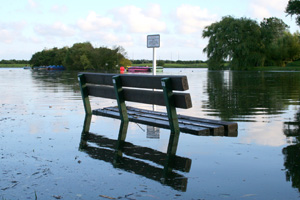Integrated flood risk management in Sweden
Even though Sweden does not have any catastrophic flood risk such as countries like Bangladesh, or the Netherlands, there are anyhow socioeconomic risks associated with not investing enough in flood risk reduction. Integrated flood risk management takes advantage of the win wins of addressing not only flood risk but also other risks related with water flows such as eutrophication and environmental degradation.
To discuss this topic more in depth, the cluster group for water and disaster risk reduction at the Swedish Water House/SIWI invited a few key experts and representatives of the main actors to a seminar in November 2013.
In Sweden, county administrators have observed a slow but steady tendency for development to find its way to low lying locations, which end up being flooded from time to time. This development makes it difficult to adopt a preventive approach in the future – too late to prohibit more development, and too expensive and difficult to relocate or change land use. Integrated flood risk management could provide a comprehensive and preventive approach needed.
This management approach could potentially be realised by the implementation of two European Directives: The EU Water Framework coordinated by The Swedish Agency for Marine and Water Management (HaV) and the EU Flood Directive coordination by the Swedish Civil Contingency Agency (MSB). MSB has, as a first step of implementing the Flood Directive in Sweden identified 18 areas with potential significant flood risk. In the future stages there will be more focus on smaller flows, where MSB welcomes cooperation with others agencies, for example HaV. In most other European countries the Flood Directive and the Water Framework Directive are coordinated by the same agency. Having them at separate agencies will require a lot of joint activities by MSB and HaV to realize the synergies and guide future implementation. The future steps also include the County Administration boards –the regional representation of the governmental institutions, to make flood risk maps and management plans.
To adapt the Swedish flood risk approach to these two directives and to develop inte-grated flood risk management in Sweden will require effort in a few key areas, which are summarised below:
Firstly, Sweden’s traditional approach to manage water flows is based on an outdated legislation on water and drainage. When urban areas develop, the amount and speed of storm water runoff is increased due to increase of impervious surfaces. The management of water flows – through land drainage structures, ditches and dykes, are very difficult to change, requiring consensus of all owners – often several landowners, who have agreed to collaborate under a joint property society. The Swedish legislation is set up to require action by each joint society; one by one, so it takes decades to implement change. With climate change predictions, extreme precipitation is likely to increase 20 -25% by 2100 putting even more pressure on drainage and water flow management. It is also likely with more “monster rains” one which hit Copenhagen on 2 July 2011 with 150 mm rain in 2 hours. Swedish urban areas are not prepared for such water volumes. To trigger action in these areas some argue that more specific guidance is needed to make up for the gaps in legislation.
Secondly, planning frameworks are inadequate. The role of the municipal comprehensive planning is strong in Sweden, but the water flows go beyond municipal borders and work at river basin scales. Larger planning frameworks also encourage a mix of measures including upstream management which is more diffuse, and to move away from predominantly investing in local structural measures. This also gives new opportunities for recreation, culture, and nature. This require functional and effective platforms for bottom up collaboration as there are many actors involved and often a lack of clear responsibilities between them.
Thirdly, on the urban scale, some argue the tools exist but are not used; and the action is lacking to prepare for such “monster rains” as in Copenhagen. But for example places like Härryda, Malmö or Helsingborg, have already adopted adaptive storm water management to cope with larger flows.
Fourthly but not least important, financing is needed for preventive and mitigating measures, with the rationale that this is an investment which pays back to society later on.
Read more about the seminar here.








